Theodor Seuss Geisel's World War II Cartoons: A Political Analysis
VerifiedAdded on 2022/08/15
|8
|1873
|10
Essay
AI Summary
This essay provides a comprehensive analysis of Theodor Seuss Geisel's (Dr. Seuss) World War II editorial cartoons, focusing on their political messages and satirical techniques. It examines how Dr. Seuss used his art to critique American isolationism, expose the dangers of fascism and Nazism, and pro...

Name of the Student
Name of the University
Author Note
Dr.Sesus Goes to War
Theodor who had been widely famed by his reputation as a cartoonist as well as an
eminent person in the domain of children literature. However, there has been differences in
opinion in considering his work of art as a form of Political standpoint. The cartoons as they
had appeared in the New York Newspaper. The [paper would like to use the gap in
considering the work of a children author as a form of political agenda. The concern of the
essay is to elucidate how one of the communicative form of art and literature has been used
by Theodor Seuss Geisel as a mode of political propaganda to make the situation of the rest
of the world explicate in front of the Americans (Kazmaz).
The cartoons chalked out by Dr.Seuss was highly satirical in nature and they had been
framed around the basic philosophy of the Newspaper PM who used belief in the ideology
that the ‘people should not be pushed around’. However, in contrast to the other portrayal of
the political agenda what the readers experience here is an appeal to the common sense of the
readers instead of aggressive persuasion. One of the early cartoon portrayed the ostrich
bonnets that had been used by Hitler to gain some relief. The cartoon has been a criticism of
the infamous gas chamber under the Nazi regime where the Jewish people had been
persecuted relentlessly under the project of creating a world of ‘purer’ race (West).
Through the cartoon concerned Dr.Seuss tried to aim his criticism towards Charles
Lindbergh who had voiced for a non-intervention on the part of the Americans who had been
urged not to participate or communicate about the happenings in the Germany under Nazi
Name of the University
Author Note
Dr.Sesus Goes to War
Theodor who had been widely famed by his reputation as a cartoonist as well as an
eminent person in the domain of children literature. However, there has been differences in
opinion in considering his work of art as a form of Political standpoint. The cartoons as they
had appeared in the New York Newspaper. The [paper would like to use the gap in
considering the work of a children author as a form of political agenda. The concern of the
essay is to elucidate how one of the communicative form of art and literature has been used
by Theodor Seuss Geisel as a mode of political propaganda to make the situation of the rest
of the world explicate in front of the Americans (Kazmaz).
The cartoons chalked out by Dr.Seuss was highly satirical in nature and they had been
framed around the basic philosophy of the Newspaper PM who used belief in the ideology
that the ‘people should not be pushed around’. However, in contrast to the other portrayal of
the political agenda what the readers experience here is an appeal to the common sense of the
readers instead of aggressive persuasion. One of the early cartoon portrayed the ostrich
bonnets that had been used by Hitler to gain some relief. The cartoon has been a criticism of
the infamous gas chamber under the Nazi regime where the Jewish people had been
persecuted relentlessly under the project of creating a world of ‘purer’ race (West).
Through the cartoon concerned Dr.Seuss tried to aim his criticism towards Charles
Lindbergh who had voiced for a non-intervention on the part of the Americans who had been
urged not to participate or communicate about the happenings in the Germany under Nazi
Paraphrase This Document
Need a fresh take? Get an instant paraphrase of this document with our AI Paraphraser
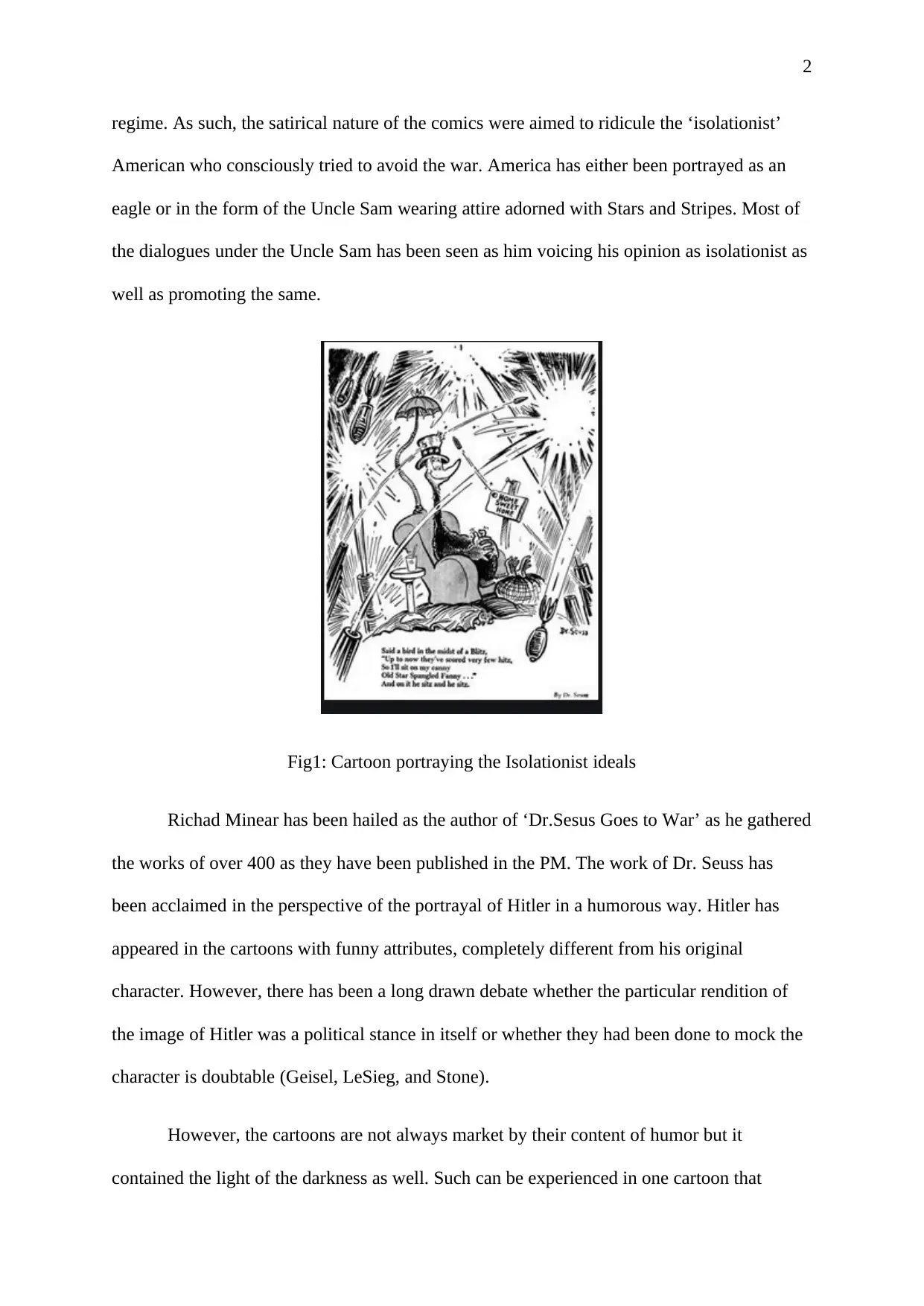
2
regime. As such, the satirical nature of the comics were aimed to ridicule the ‘isolationist’
American who consciously tried to avoid the war. America has either been portrayed as an
eagle or in the form of the Uncle Sam wearing attire adorned with Stars and Stripes. Most of
the dialogues under the Uncle Sam has been seen as him voicing his opinion as isolationist as
well as promoting the same.
Fig1: Cartoon portraying the Isolationist ideals
Richad Minear has been hailed as the author of ‘Dr.Sesus Goes to War’ as he gathered
the works of over 400 as they have been published in the PM. The work of Dr. Seuss has
been acclaimed in the perspective of the portrayal of Hitler in a humorous way. Hitler has
appeared in the cartoons with funny attributes, completely different from his original
character. However, there has been a long drawn debate whether the particular rendition of
the image of Hitler was a political stance in itself or whether they had been done to mock the
character is doubtable (Geisel, LeSieg, and Stone).
However, the cartoons are not always market by their content of humor but it
contained the light of the darkness as well. Such can be experienced in one cartoon that
regime. As such, the satirical nature of the comics were aimed to ridicule the ‘isolationist’
American who consciously tried to avoid the war. America has either been portrayed as an
eagle or in the form of the Uncle Sam wearing attire adorned with Stars and Stripes. Most of
the dialogues under the Uncle Sam has been seen as him voicing his opinion as isolationist as
well as promoting the same.
Fig1: Cartoon portraying the Isolationist ideals
Richad Minear has been hailed as the author of ‘Dr.Sesus Goes to War’ as he gathered
the works of over 400 as they have been published in the PM. The work of Dr. Seuss has
been acclaimed in the perspective of the portrayal of Hitler in a humorous way. Hitler has
appeared in the cartoons with funny attributes, completely different from his original
character. However, there has been a long drawn debate whether the particular rendition of
the image of Hitler was a political stance in itself or whether they had been done to mock the
character is doubtable (Geisel, LeSieg, and Stone).
However, the cartoons are not always market by their content of humor but it
contained the light of the darkness as well. Such can be experienced in one cartoon that
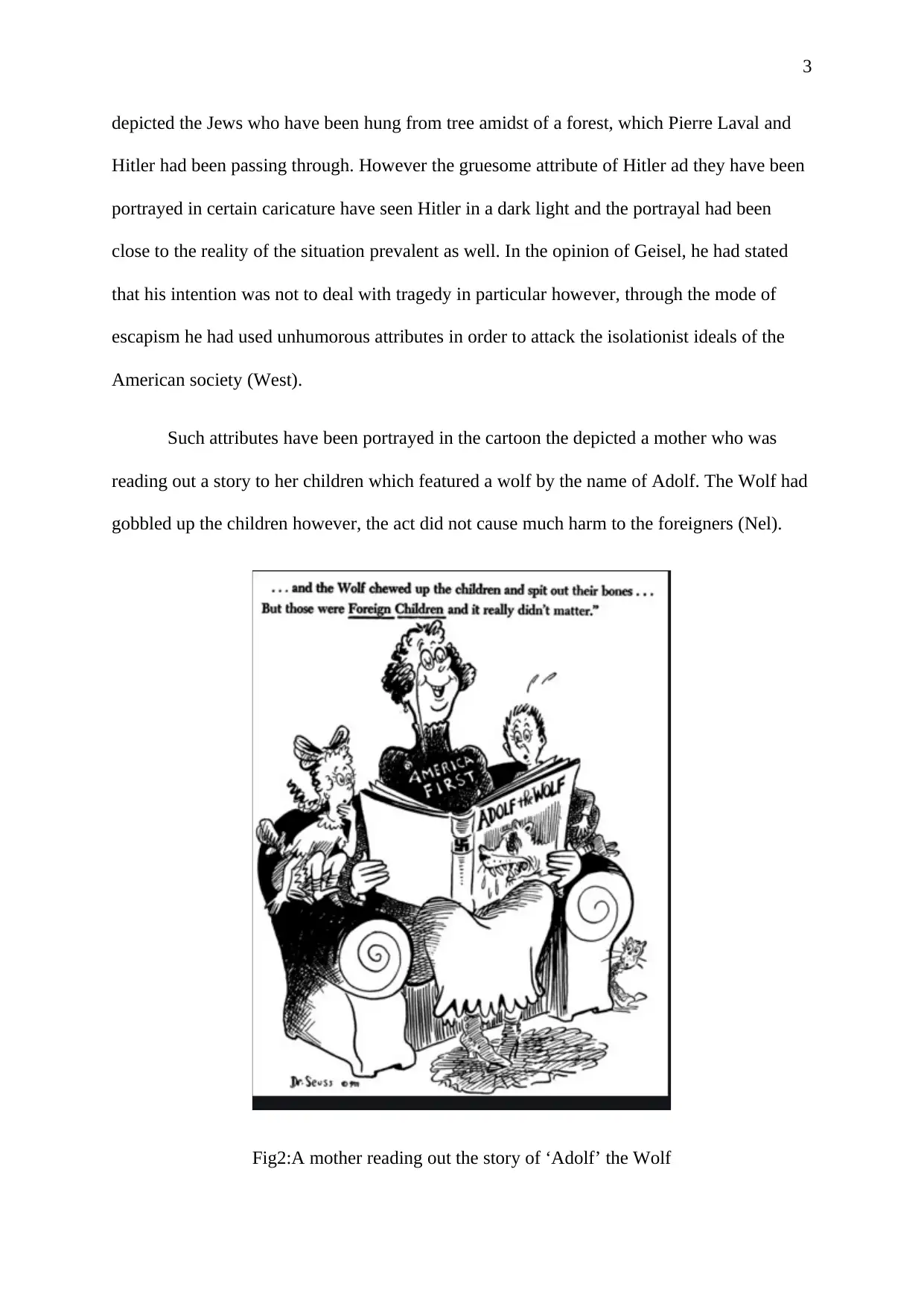
3
depicted the Jews who have been hung from tree amidst of a forest, which Pierre Laval and
Hitler had been passing through. However the gruesome attribute of Hitler ad they have been
portrayed in certain caricature have seen Hitler in a dark light and the portrayal had been
close to the reality of the situation prevalent as well. In the opinion of Geisel, he had stated
that his intention was not to deal with tragedy in particular however, through the mode of
escapism he had used unhumorous attributes in order to attack the isolationist ideals of the
American society (West).
Such attributes have been portrayed in the cartoon the depicted a mother who was
reading out a story to her children which featured a wolf by the name of Adolf. The Wolf had
gobbled up the children however, the act did not cause much harm to the foreigners (Nel).
Fig2:A mother reading out the story of ‘Adolf’ the Wolf
depicted the Jews who have been hung from tree amidst of a forest, which Pierre Laval and
Hitler had been passing through. However the gruesome attribute of Hitler ad they have been
portrayed in certain caricature have seen Hitler in a dark light and the portrayal had been
close to the reality of the situation prevalent as well. In the opinion of Geisel, he had stated
that his intention was not to deal with tragedy in particular however, through the mode of
escapism he had used unhumorous attributes in order to attack the isolationist ideals of the
American society (West).
Such attributes have been portrayed in the cartoon the depicted a mother who was
reading out a story to her children which featured a wolf by the name of Adolf. The Wolf had
gobbled up the children however, the act did not cause much harm to the foreigners (Nel).
Fig2:A mother reading out the story of ‘Adolf’ the Wolf
⊘ This is a preview!⊘
Do you want full access?
Subscribe today to unlock all pages.

Trusted by 1+ million students worldwide
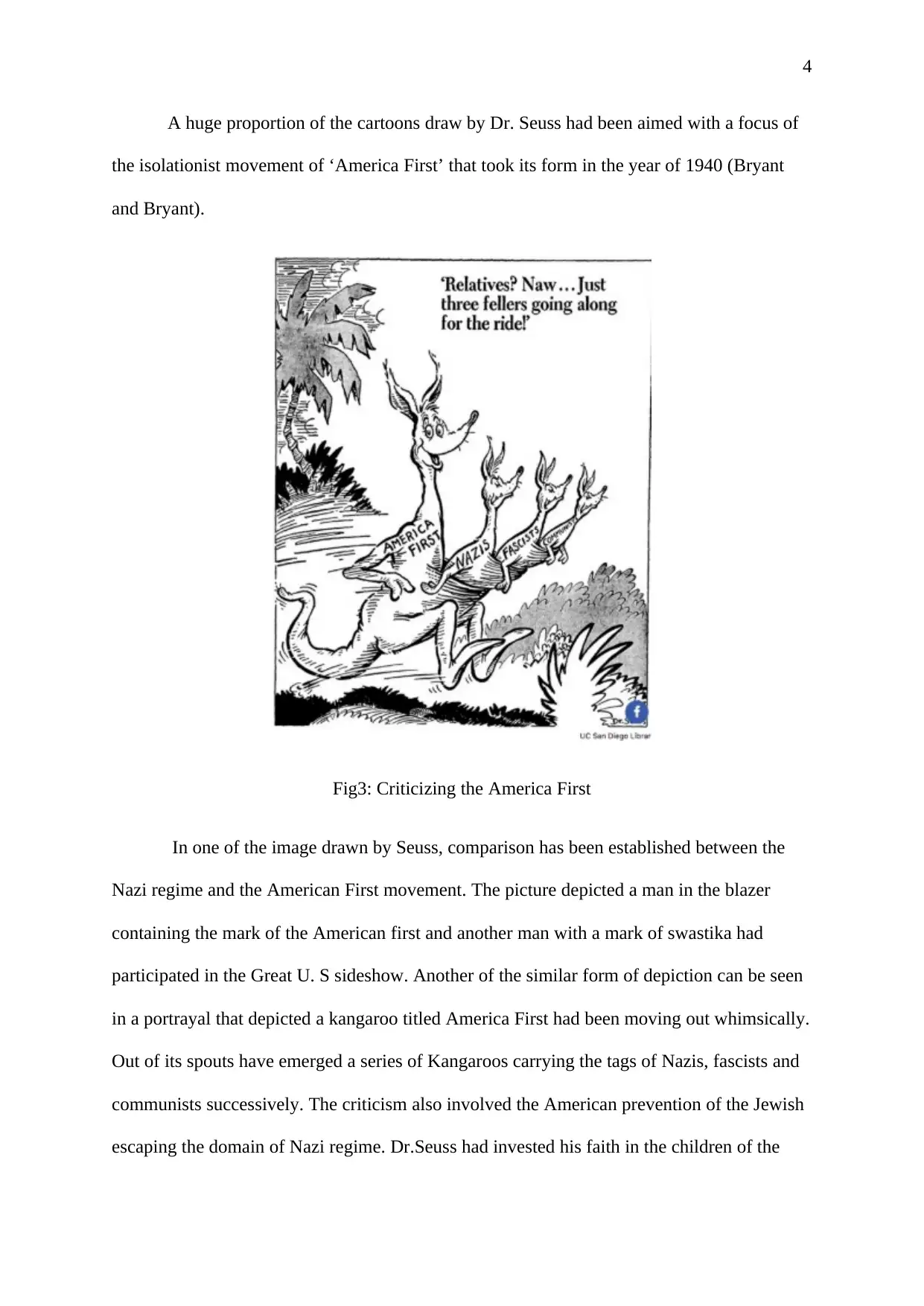
4
A huge proportion of the cartoons draw by Dr. Seuss had been aimed with a focus of
the isolationist movement of ‘America First’ that took its form in the year of 1940 (Bryant
and Bryant).
Fig3: Criticizing the America First
In one of the image drawn by Seuss, comparison has been established between the
Nazi regime and the American First movement. The picture depicted a man in the blazer
containing the mark of the American first and another man with a mark of swastika had
participated in the Great U. S sideshow. Another of the similar form of depiction can be seen
in a portrayal that depicted a kangaroo titled America First had been moving out whimsically.
Out of its spouts have emerged a series of Kangaroos carrying the tags of Nazis, fascists and
communists successively. The criticism also involved the American prevention of the Jewish
escaping the domain of Nazi regime. Dr.Seuss had invested his faith in the children of the
A huge proportion of the cartoons draw by Dr. Seuss had been aimed with a focus of
the isolationist movement of ‘America First’ that took its form in the year of 1940 (Bryant
and Bryant).
Fig3: Criticizing the America First
In one of the image drawn by Seuss, comparison has been established between the
Nazi regime and the American First movement. The picture depicted a man in the blazer
containing the mark of the American first and another man with a mark of swastika had
participated in the Great U. S sideshow. Another of the similar form of depiction can be seen
in a portrayal that depicted a kangaroo titled America First had been moving out whimsically.
Out of its spouts have emerged a series of Kangaroos carrying the tags of Nazis, fascists and
communists successively. The criticism also involved the American prevention of the Jewish
escaping the domain of Nazi regime. Dr.Seuss had invested his faith in the children of the
Paraphrase This Document
Need a fresh take? Get an instant paraphrase of this document with our AI Paraphraser
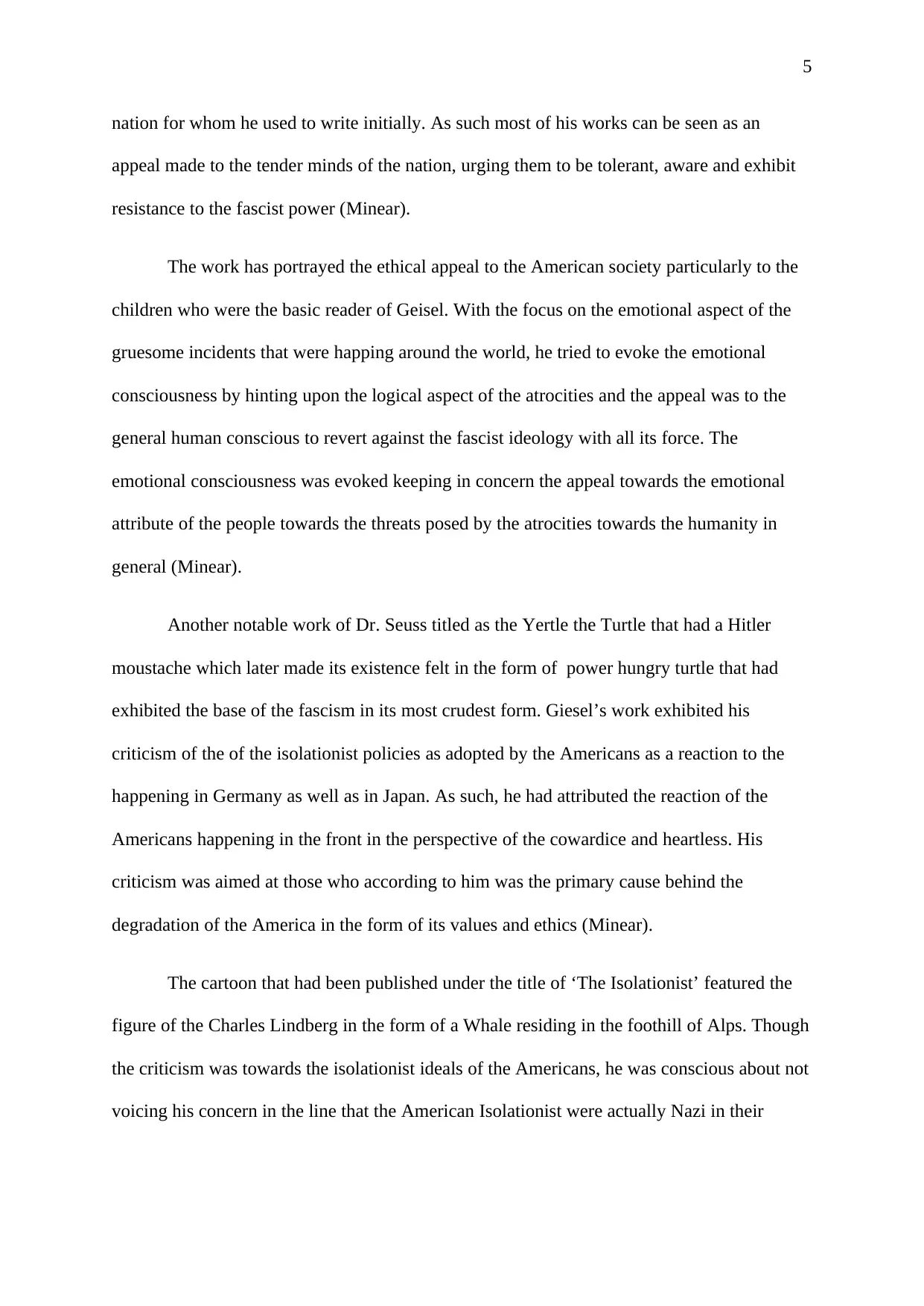
5
nation for whom he used to write initially. As such most of his works can be seen as an
appeal made to the tender minds of the nation, urging them to be tolerant, aware and exhibit
resistance to the fascist power (Minear).
The work has portrayed the ethical appeal to the American society particularly to the
children who were the basic reader of Geisel. With the focus on the emotional aspect of the
gruesome incidents that were happing around the world, he tried to evoke the emotional
consciousness by hinting upon the logical aspect of the atrocities and the appeal was to the
general human conscious to revert against the fascist ideology with all its force. The
emotional consciousness was evoked keeping in concern the appeal towards the emotional
attribute of the people towards the threats posed by the atrocities towards the humanity in
general (Minear).
Another notable work of Dr. Seuss titled as the Yertle the Turtle that had a Hitler
moustache which later made its existence felt in the form of power hungry turtle that had
exhibited the base of the fascism in its most crudest form. Giesel’s work exhibited his
criticism of the of the isolationist policies as adopted by the Americans as a reaction to the
happening in Germany as well as in Japan. As such, he had attributed the reaction of the
Americans happening in the front in the perspective of the cowardice and heartless. His
criticism was aimed at those who according to him was the primary cause behind the
degradation of the America in the form of its values and ethics (Minear).
The cartoon that had been published under the title of ‘The Isolationist’ featured the
figure of the Charles Lindberg in the form of a Whale residing in the foothill of Alps. Though
the criticism was towards the isolationist ideals of the Americans, he was conscious about not
voicing his concern in the line that the American Isolationist were actually Nazi in their
nation for whom he used to write initially. As such most of his works can be seen as an
appeal made to the tender minds of the nation, urging them to be tolerant, aware and exhibit
resistance to the fascist power (Minear).
The work has portrayed the ethical appeal to the American society particularly to the
children who were the basic reader of Geisel. With the focus on the emotional aspect of the
gruesome incidents that were happing around the world, he tried to evoke the emotional
consciousness by hinting upon the logical aspect of the atrocities and the appeal was to the
general human conscious to revert against the fascist ideology with all its force. The
emotional consciousness was evoked keeping in concern the appeal towards the emotional
attribute of the people towards the threats posed by the atrocities towards the humanity in
general (Minear).
Another notable work of Dr. Seuss titled as the Yertle the Turtle that had a Hitler
moustache which later made its existence felt in the form of power hungry turtle that had
exhibited the base of the fascism in its most crudest form. Giesel’s work exhibited his
criticism of the of the isolationist policies as adopted by the Americans as a reaction to the
happening in Germany as well as in Japan. As such, he had attributed the reaction of the
Americans happening in the front in the perspective of the cowardice and heartless. His
criticism was aimed at those who according to him was the primary cause behind the
degradation of the America in the form of its values and ethics (Minear).
The cartoon that had been published under the title of ‘The Isolationist’ featured the
figure of the Charles Lindberg in the form of a Whale residing in the foothill of Alps. Though
the criticism was towards the isolationist ideals of the Americans, he was conscious about not
voicing his concern in the line that the American Isolationist were actually Nazi in their
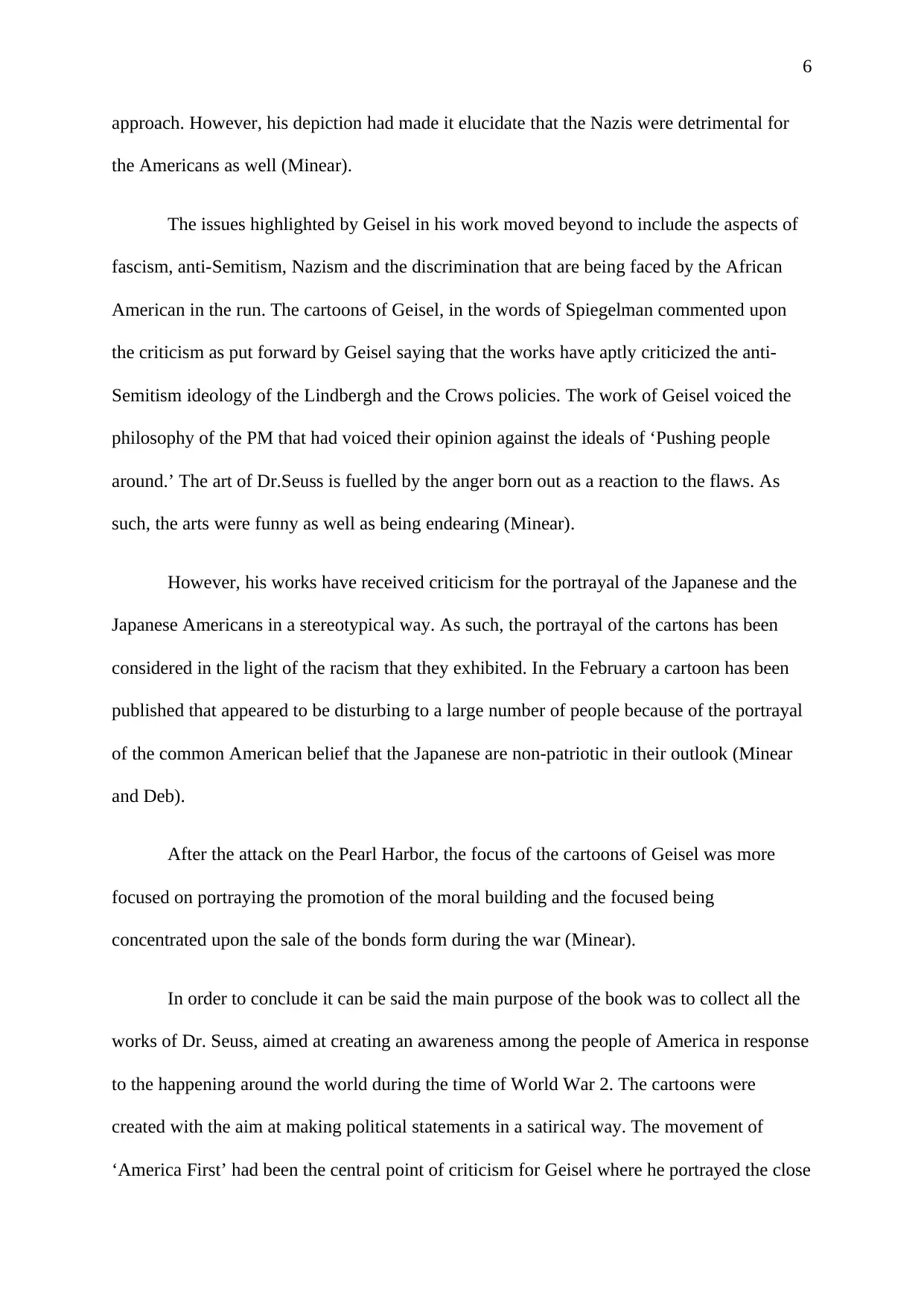
6
approach. However, his depiction had made it elucidate that the Nazis were detrimental for
the Americans as well (Minear).
The issues highlighted by Geisel in his work moved beyond to include the aspects of
fascism, anti-Semitism, Nazism and the discrimination that are being faced by the African
American in the run. The cartoons of Geisel, in the words of Spiegelman commented upon
the criticism as put forward by Geisel saying that the works have aptly criticized the anti-
Semitism ideology of the Lindbergh and the Crows policies. The work of Geisel voiced the
philosophy of the PM that had voiced their opinion against the ideals of ‘Pushing people
around.’ The art of Dr.Seuss is fuelled by the anger born out as a reaction to the flaws. As
such, the arts were funny as well as being endearing (Minear).
However, his works have received criticism for the portrayal of the Japanese and the
Japanese Americans in a stereotypical way. As such, the portrayal of the cartons has been
considered in the light of the racism that they exhibited. In the February a cartoon has been
published that appeared to be disturbing to a large number of people because of the portrayal
of the common American belief that the Japanese are non-patriotic in their outlook (Minear
and Deb).
After the attack on the Pearl Harbor, the focus of the cartoons of Geisel was more
focused on portraying the promotion of the moral building and the focused being
concentrated upon the sale of the bonds form during the war (Minear).
In order to conclude it can be said the main purpose of the book was to collect all the
works of Dr. Seuss, aimed at creating an awareness among the people of America in response
to the happening around the world during the time of World War 2. The cartoons were
created with the aim at making political statements in a satirical way. The movement of
‘America First’ had been the central point of criticism for Geisel where he portrayed the close
approach. However, his depiction had made it elucidate that the Nazis were detrimental for
the Americans as well (Minear).
The issues highlighted by Geisel in his work moved beyond to include the aspects of
fascism, anti-Semitism, Nazism and the discrimination that are being faced by the African
American in the run. The cartoons of Geisel, in the words of Spiegelman commented upon
the criticism as put forward by Geisel saying that the works have aptly criticized the anti-
Semitism ideology of the Lindbergh and the Crows policies. The work of Geisel voiced the
philosophy of the PM that had voiced their opinion against the ideals of ‘Pushing people
around.’ The art of Dr.Seuss is fuelled by the anger born out as a reaction to the flaws. As
such, the arts were funny as well as being endearing (Minear).
However, his works have received criticism for the portrayal of the Japanese and the
Japanese Americans in a stereotypical way. As such, the portrayal of the cartons has been
considered in the light of the racism that they exhibited. In the February a cartoon has been
published that appeared to be disturbing to a large number of people because of the portrayal
of the common American belief that the Japanese are non-patriotic in their outlook (Minear
and Deb).
After the attack on the Pearl Harbor, the focus of the cartoons of Geisel was more
focused on portraying the promotion of the moral building and the focused being
concentrated upon the sale of the bonds form during the war (Minear).
In order to conclude it can be said the main purpose of the book was to collect all the
works of Dr. Seuss, aimed at creating an awareness among the people of America in response
to the happening around the world during the time of World War 2. The cartoons were
created with the aim at making political statements in a satirical way. The movement of
‘America First’ had been the central point of criticism for Geisel where he portrayed the close
⊘ This is a preview!⊘
Do you want full access?
Subscribe today to unlock all pages.

Trusted by 1+ million students worldwide
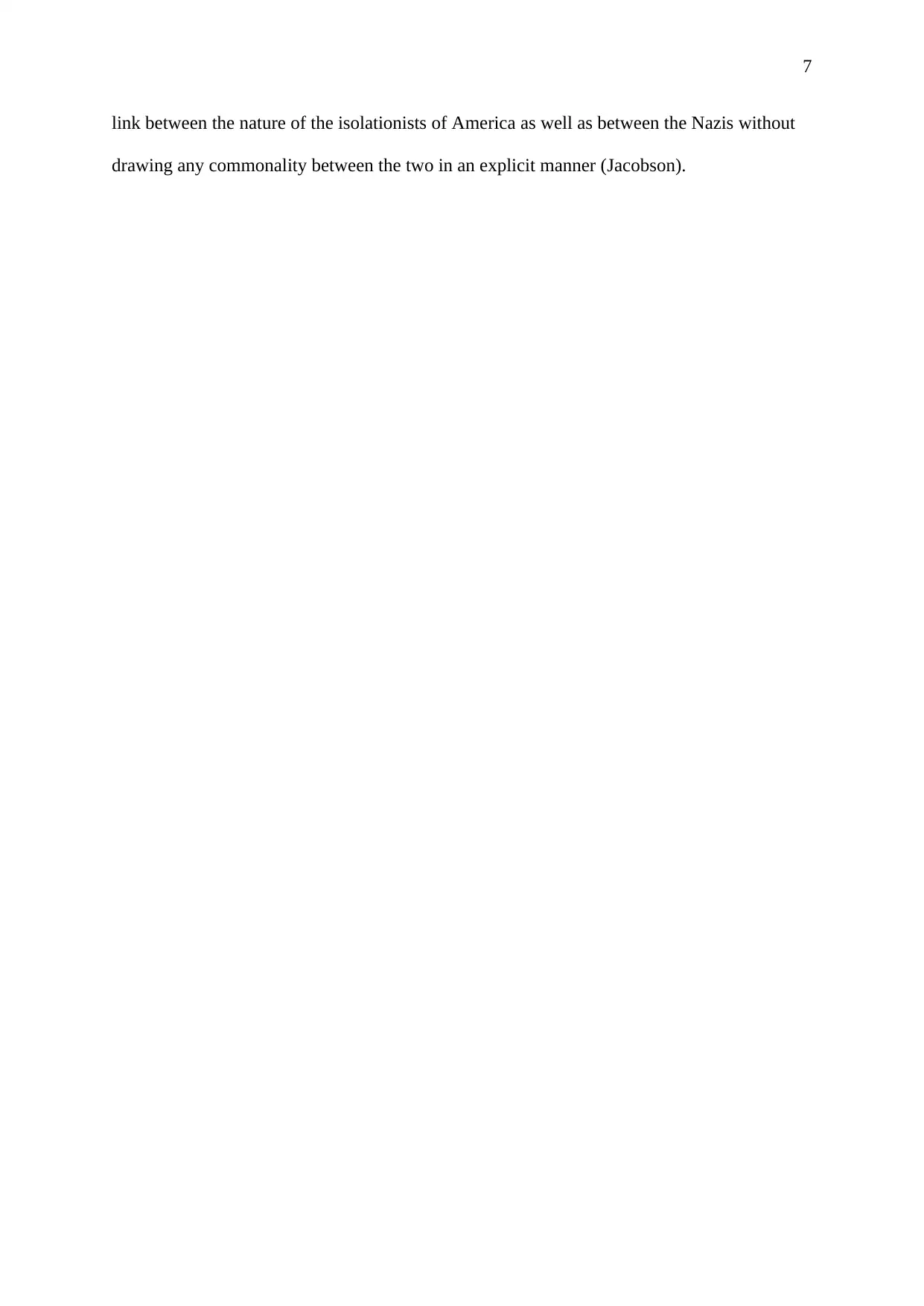
7
link between the nature of the isolationists of America as well as between the Nazis without
drawing any commonality between the two in an explicit manner (Jacobson).
link between the nature of the isolationists of America as well as between the Nazis without
drawing any commonality between the two in an explicit manner (Jacobson).
Paraphrase This Document
Need a fresh take? Get an instant paraphrase of this document with our AI Paraphraser
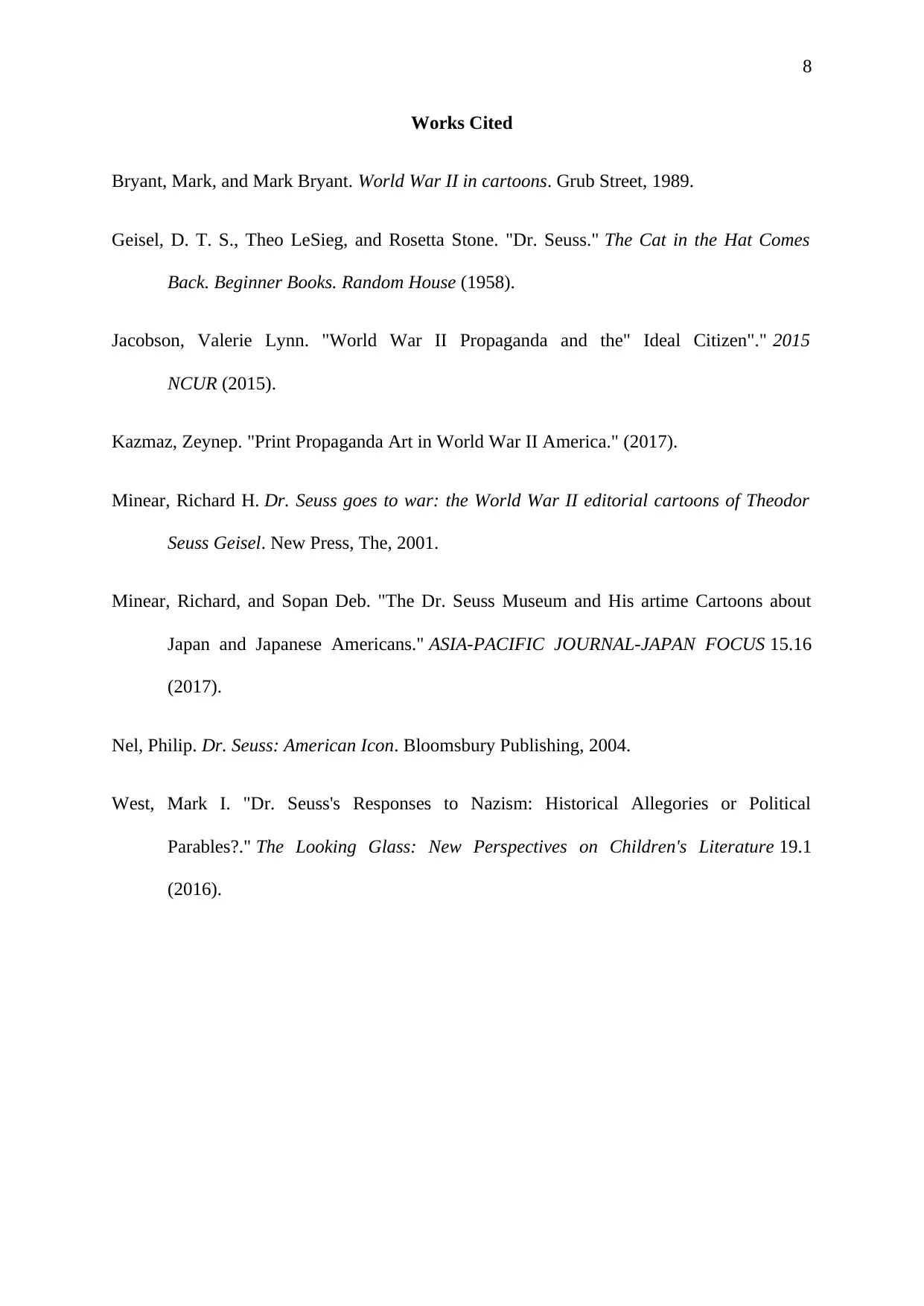
8
Works Cited
Bryant, Mark, and Mark Bryant. World War II in cartoons. Grub Street, 1989.
Geisel, D. T. S., Theo LeSieg, and Rosetta Stone. "Dr. Seuss." The Cat in the Hat Comes
Back. Beginner Books. Random House (1958).
Jacobson, Valerie Lynn. "World War II Propaganda and the" Ideal Citizen"." 2015
NCUR (2015).
Kazmaz, Zeynep. "Print Propaganda Art in World War II America." (2017).
Minear, Richard H. Dr. Seuss goes to war: the World War II editorial cartoons of Theodor
Seuss Geisel. New Press, The, 2001.
Minear, Richard, and Sopan Deb. "The Dr. Seuss Museum and His artime Cartoons about
Japan and Japanese Americans." ASIA-PACIFIC JOURNAL-JAPAN FOCUS 15.16
(2017).
Nel, Philip. Dr. Seuss: American Icon. Bloomsbury Publishing, 2004.
West, Mark I. "Dr. Seuss's Responses to Nazism: Historical Allegories or Political
Parables?." The Looking Glass: New Perspectives on Children's Literature 19.1
(2016).
Works Cited
Bryant, Mark, and Mark Bryant. World War II in cartoons. Grub Street, 1989.
Geisel, D. T. S., Theo LeSieg, and Rosetta Stone. "Dr. Seuss." The Cat in the Hat Comes
Back. Beginner Books. Random House (1958).
Jacobson, Valerie Lynn. "World War II Propaganda and the" Ideal Citizen"." 2015
NCUR (2015).
Kazmaz, Zeynep. "Print Propaganda Art in World War II America." (2017).
Minear, Richard H. Dr. Seuss goes to war: the World War II editorial cartoons of Theodor
Seuss Geisel. New Press, The, 2001.
Minear, Richard, and Sopan Deb. "The Dr. Seuss Museum and His artime Cartoons about
Japan and Japanese Americans." ASIA-PACIFIC JOURNAL-JAPAN FOCUS 15.16
(2017).
Nel, Philip. Dr. Seuss: American Icon. Bloomsbury Publishing, 2004.
West, Mark I. "Dr. Seuss's Responses to Nazism: Historical Allegories or Political
Parables?." The Looking Glass: New Perspectives on Children's Literature 19.1
(2016).
1 out of 8
Your All-in-One AI-Powered Toolkit for Academic Success.
+13062052269
info@desklib.com
Available 24*7 on WhatsApp / Email
![[object Object]](/_next/static/media/star-bottom.7253800d.svg)
Unlock your academic potential
© 2024 | Zucol Services PVT LTD | All rights reserved.